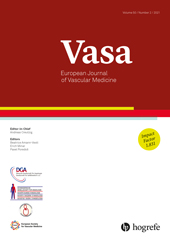Evaluation of mortality following paclitaxel drug-coated balloon angioplasty of femoropopliteal lesions in patients with ulcerations and gangrene – a single center experience
Abstract
Summary:Background: A recent meta-analysis of randomized controlled trials suggested an increased long-term mortality risk following femoropopliteal angioplasty using paclitaxel coated devices. To assess the long-term mortality after paclitaxel drug-coated (DCB) and uncoated balloon angioplasty (POBA) of femoropopliteal lesions in patients with ulcerations and gangrene in real world practice. Patients and methods: A retrospective mortality analysis of patients with at least 3-year follow-up who underwent balloon based endovascular therapy of femoropopliteal lesions was performed. Results: Overall 624 patients with femoropopliteal lesions were included in this study. Of those, 197 patients were treated with POBA without crossover to a paclitaxel coated device during follow-up and 427 patients with DCB angioplasty. Mean follow-up time was 33.3 ± 25.4 months. Mortality incidence was 81.7% (95% confidence interval [95% CI]: 76.1–86.8) after POBA and 59.0% (95% CI: 54.6–63.9) after DCB (p < 0.001). Multivariate logistic regression analysis revealed type of treatment (POBA vs. DCB, (hazard ratio [HR]: 0.332, 95% CI: 0.215–0.514, p < 0.001), age per year (HR: 1.065, 95% CI: 1.046–1.087, p < 0.001), coronary heart disease (HR: 1.969, 95% CI: 1.323–2.930, p = 0.001), renal insufficiency (HR: 1.583, 95% CI: 1.079–2.323, p = 0.019), stroke (HR: 2.505, 95% CI: 1.431–4.384, p = 0.001) as predictors for all-cause mortality. In the subgroup excluding octogenarians, mortality predictors were type of treatment (HR: 0.463, 95% CI: 0.269–0.796, p = 0.005), age per year (HR: 1.035, 95% CI: 1.002–1.069, p = 0.038), coronary heart disease (HR: 2.082, 95% CI: 1.274–3.400, p = 0.003), stroke (HR: 2.203, 95% CI: 1.156–4.197, p = 0.016) and renal insufficiency (HR: 2.201, 95% CI: 1.357–3.571, p < 0.001). Conclusions: This monocentric retrospective analysis showed no survival disadvantage for patients in Rutherford-Becker stage 5 after treatment with paclitaxel-coated balloons.
References
1 Comparison of global estimates of prevalence and risk factors for peripheral artery disease in 2000 and 2010: a systematic review and analysis. Lancet. 2013;382:1329–40.
2 . Standards for evaluating and reporting the results of surgical and percutaneous therapy for peripheral arterial disease. J Vasc Interv Radiol. 1991;2:169–74.
3 Peripheral arterial disease and critical limb ischaemia: still poor outcomes and lack of guideline adherence. Eur Heart J. 2015;36:932–8.
4 . Characteristics and outcome of patients hospitalised for lower extremity peripheral artery disease in France: the COPART Registry. Eur J of Vas Endovasc Surg. 2010;39:577–85.
5 Inter-society consensus for the management of peripheral arterial disease (TASC II). J Vasc Surg. 2007;45:S5–S67.
6 SCAI consensus guidelines for device selection in femoral-popliteal arterial interventions. Catheter Cardiovasc Interv. 2018;92:124–40.
7 ACC/AHA/SCAI/SIR/SVM 2018 Appropriate Use Criteria for Peripheral Artery Intervention: A Report of the American College of Cardiology Appropriate Use Criteria Task Force, American Heart Association, Society for Cardiovascular Angiography and Interventions, Society of Interventional Radiology, and Society for Vascular Medicine. J Am Coll Cardiol. 2019;73:214–37.
8 . Risk of death following application of paclitaxel-coated balloons and stents in the femoropopliteal artery of the leg: A systematic review and meta-analysis of randomized controlled trials. J Am Heart Assoc. 2018;7:e011245.
9 . ELUVIA Drug-Eluting Vascular Stent System [Internet]. 2018 Sep; 18 [cited 2018 May 7]. Available from: https://www.accessdata.fda.gov/cdrh_docs/pdf18/P180011B.pdf
10 . IN.PACT admiral paclitaxel-coated PTA balloon catheter summary of safety and effectiveness data [Internet]. 2014 Dec; 30 [cited 2014 May 7]. Available from: https://www.accessdata.fda.gov/cdrh_docs/pdf14/P140010B.pdf
11 . LUTONIX 035 drug coated balloon PTA catheter (AVF indiction) summary of safety and effectiveness data [Internet]. 2017 Feb; 7 [cited 2017 May 7]. Available from: https://www.accessdata.fda.gov/cdrh_docs/pdf13/P130024S009B.pdf
12 . Stellarex 0.035” OTW drug-coated angioplasty balloon summary of safety and effectiveness data [Internet]. 2017 Jul; 26 [cited 2017 May 7]. Available from: https://www.accessdata.fda.gov/cdrh_docs/pdf16/P160049B.pdf
13 . Zilver®PTX® drug-eluting peripheral stent, instructions for use. IFU 0118-6.
14 Mortality not correlated with paclitaxel exposure: an independent patient-level meta-analysis of a drug-coated balloon. J Am Coll Cardiol. 2019;73:2550–63.
15 Five-year follow-up data of the Thunder trial: angioplasty of femoro-popliteal arteries with drug-coated balloons. JACC Cardiovasc Interv. 2015;8:102–8.
16 Inhibition of restenosis in femoropopliteal arteries: paclitaxel-coated versus uncoated balloon: femoral paclitaxel randomized pilot trial. Circulation. 2008;118:1358–65.
17 Paclitaxel-coated balloons reduce restenosis after femoro-popliteal angioplasty: evidence from the randomized PACIFIER trial. Circ Cardiovasc Interv. 2012;5:831–40.
18 Two-year clinical outcomes of the CONSEQUENT trial: can femoropopliteal lesions be treated with sustainable clinical results that are economically sound? Cardiovasc Intervent Radiol. 2018;41:1008–14.
19 . Two-year mortality after angioplasty of the femoro-popliteal artery with uncoated balloons and paclitaxel-coated balloons – a pooled analysis of four randomized controlled multicenter trials. Cardiovasc Intervent Radiol. 2019;42:949–55.
20 Mortality and paclitaxel-coated devices: an individual patient data meta-analysis. Circulation. 2020;141(23):1859–69.
21 The LEVANT I (Lutonix paclitaxel-coated balloon for the prevention of femoropopliteal restenosis) trial for femoropopliteal revascularization: first-in-human randomized trial of low-dose drug-coated balloon versus uncoated balloon angioplasty. JACC Cardiovasc Interv. 2014;7:10–9.
22 Drug-coated balloon versus standard percutaneous transluminal angioplasty for the treatment of superficial femoral and popliteal peripheral artery disease: 12-month results from the IN.PACT SFA randomized trial. Circulation. 2015;131:495–502.
23 Durable clinical effectiveness with paclitaxel-eluting stents in the femoropopliteal artery: 5-year results of the Zilver PTX randomized trial. Circulation. 2016;133:1472–83.
24 Stellarex drug-coated balloon for treatment of femoropopliteal arterial disease – The ILLUMENATE Global Study: 12-Month results from a prospective, multicenter, single-arm study. Catheter Cardiovasc Interv. 2018;91:497–504.
25 Impact of frailty on clinical outcomes in patients with critical limb ischemia. Circ: Cardiovasc Interv. 2018;11:e006778.
26 Comparison of interventional outcomes according to preoperative indication: a single center analysis of 2,240 limb revascularizations. J Am Coll Surg. 2009;208:770–8.
27 . Meta-analysis of contemporary short-and long-term mortality rates in patients diagnosed with critical leg ischaemia. Br J Surg. 2013;100:1002–8.



